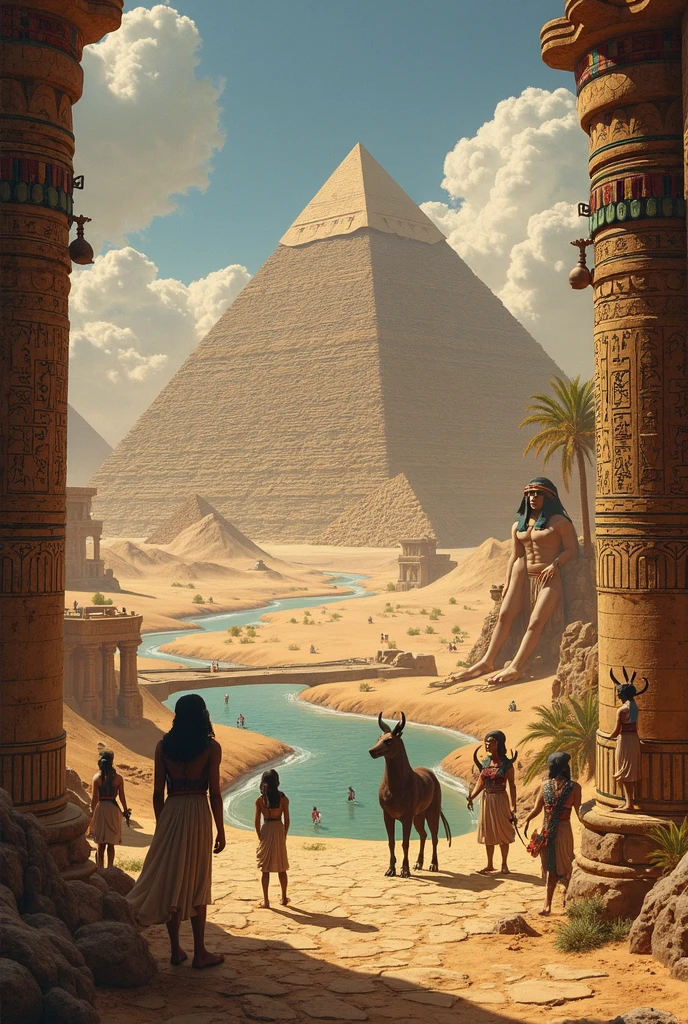Aboriginal Mythology: The Sacred Stories of Australia
The rich tapestry of Aboriginal mythology is deeply intertwined with the land, culture, and spirituality of Australia’s Indigenous peoples. Central to these beliefs is the concept of the Dreamtime, a sacred era when ancestral beings shaped the world. Stories of the Rainbow Serpent, the Wandjina, and other powerful figures continue to influence Aboriginal traditions today.
The Dreamtime: Foundation of Aboriginal Beliefs
The Dreamtime, also known as Tjukurpa or Alcheringa, refers to the time of creation when ancestral spirits roamed the Earth, forming landscapes, animals, and laws. Unlike Western notions of linear time, the Dreamtime is both past and present, connecting people to their origins.
- Creation Stories: Each Aboriginal group has unique tales explaining how mountains, rivers, and stars came to be.
- Spiritual Connection: The land is alive with ancestral energy, and sacred sites hold deep significance.
- Oral Tradition: Knowledge is passed down through songlines, dances, and storytelling.
Key Elements of the Dreamtime
| Element | Description |
|---|---|
| Ancestors | Spiritual beings who created natural features and laws. |
| Songlines | Paths across the land that trace the journeys of ancestors. |
| Totems | Spiritual connections between clans and animals or plants. |
The Rainbow Serpent: A Powerful Creator
One of the most iconic figures in Aboriginal mythology is the Rainbow Serpent, a creator deity associated with water, fertility, and the shaping of the land. Known by different names across tribes—such as Ungud or Wonambi—this serpent is both feared and revered.
- Role in Creation: Carved rivers and valleys as it moved across the land.
- Symbolism: Represents the cycle of life, death, and rebirth.
- Cultural Significance: Ceremonies honor the serpent to ensure rain and prosperity.
The Wandjina: Cloud and Rain Spirits
In the Kimberley region, the Wandjina are powerful ancestral spirits depicted in rock art with large eyes and halos. These beings control the weather, bringing life-giving rain to the land.
| Feature | Meaning |
|---|---|
| Halos | Represent storm clouds and lightning. |
| No Mouths | Symbolize their eternal nature and power. |
| Repainting Rituals | Aboriginal communities renew the art to maintain spiritual balance. |
Ancestral Beings and Their Legacy
The ancestors of the Dreamtime are not just mythical figures—they are living presences in the land. From the Mimi spirits of Arnhem Land to the Bunyip of southeastern swamps, these beings teach moral lessons and enforce tribal laws.
Notable Ancestral Figures
- Baiame: A sky father figure in southeastern tribes.
- Tiddalik: A greedy frog whose thirst caused a great flood.
- Yhi: The sun goddess who brought light to the world.
Modern Relevance of Aboriginal Mythology
Today, Aboriginal mythology remains a vital part of Indigenous identity and cultural preservation. Efforts to protect sacred sites and revive traditional practices ensure these stories endure for future generations.
For further reading, explore these resources:
- Australian Museum: The Dreaming
- Aboriginal Art & Culture: Dreamtime Stories
- National Museum of Australia: Rainbow Serpent
Descubre más artículos fascinantes sobre mitología y cultura en nuestra web y síguenos en facebook.com/zatiandrops.
The Role of Women in Aboriginal Mythology
While many Aboriginal myths feature male ancestral beings, female figures play equally vital roles in creation stories and cultural teachings. The Seven Sisters (Pleiades) star cluster, for example, appears in multiple Aboriginal traditions as a group of women fleeing pursuit, their journey mapped across the night sky.
- Yhi (Sun Goddess): In Gunwinggu lore, she awakened life by melting ice with her warmth.
- Warramurrungundji: A fertility goddess from Arnhem Land who shaped the first humans from mud.
- Mimih Spirits: Delicate female spirits in rock art who taught hunting and dance.
Gender Balance in Dreamtime Stories
| Female Figure | Role in Mythology |
|---|---|
| Kunapipi | Earth mother associated with initiation ceremonies |
| Wawalag Sisters | Their story explains monsoons and snake symbolism |
| Djanggawul Sisters | Created sacred islands and fertility rituals |
Astronomy in Aboriginal Traditions
Aboriginal peoples developed sophisticated astronomical knowledge tied to mythology. The Emu in the Sky—a dark constellation formed by dust lanes in the Milky Way—guides seasonal activities like egg gathering. Key celestial stories include:
- Orion as a hunter (Yolngu: Ngalindi) whose punishment created the moon’s phases
- Venus as both morning (Barnumbirr) and evening star in Yolngu navigation
- Southern Cross representing a stingray or possum in various traditions
Notable Astronomical Myths
| Celestial Body | Mythological Interpretation |
|---|---|
| Moon (Mityan) | A greedy man who wasted food, now eternally shrinking and growing |
| Jupiter (Ginabongborr) | Torres Strait warrior whose campfire is visible at night |
| Coalsack Nebula | Head of the Emu in the Sky constellation |
Mythological Creatures and Warnings
Beyond ancestral beings, Aboriginal mythology features creatures serving as moral lessons or environmental warnings. The Bunyip, lurking in billabongs, deters children from dangerous waters, while the Yara-ma-yha-who (a red vampiric dwarf) enforces taboos about wandering alone.
- Quinkin: Shape-shifting rock spirits punishing lawbreakers
- Muldjewangk: River monsters protecting ecosystems from overfishing
- Kurpannga: Owl-like spirits carrying messages between worlds
Ceremonies and Rituals
Mythology comes alive through corroborees (ceremonial gatherings) where stories are enacted via dance, music, and body art. Key rituals include:
- Kunapipi: Fertility ceremonies invoking the earth mother
- Djabang: Fire dances retelling the theft of flame by the Blue-Tongued Lizard
- Wangga: Funeral rites ensuring safe passage to the spirit world
Sacred Objects in Rituals
| Object | Mythological Significance |
|---|---|
| Churinga Stones | Physical manifestations of ancestor spirits |
| Didgeridoo (Yidaki) | Represents the Rainbow Serpent’s voice |
| Feather Footprints | Symbolize ancestral journeys during sand paintings |
Regional Variations in Mythology
Australia’s diverse ecosystems gave rise to distinct mythological traditions. Coastal tribes like the Yolngu emphasize sea creatures, while desert groups like the Pitjantjatjara focus on arid-land survival wisdom.
- Northern Australia: Cyclone beings like Bralgu explain destructive storms
- Tasmania: Moihernee spirits guard burial grounds
- Central Desert: Kurriya dingo ancestors teach hunting laws
Mythology in Contemporary Art
Modern Aboriginal artists like Emily Kame Kngwarreye and Rover Thomas reinterpret Dreamtime stories through paintings, blending traditional symbols with new mediums. Common motifs include:
- U-shapes representing seated ancestors
- Concentric circles marking sacred sites
- Dotted lines tracing songlines
For deeper exploration, visit these resources:
Descubre más artículos fascinantes sobre mitología y cultura en nuestra web y síguenos en facebook.com/zatiandrops.
The Connection Between Mythology and Land Management
Aboriginal mythology isn’t just about stories—it’s a sophisticated system of ecological knowledge encoded in the Dreamtime narratives. For millennia, Indigenous Australians have used mythological principles to practice sustainable land management through:
- Fire-stick farming: Controlled burns based on ancestral teachings to regenerate plants
- Seasonal indicators: Animal behavior in myths signaling when to harvest bush foods
- Sacred site protection: Taboos preventing over-exploitation of resources
Mythological Land Management Practices
| Practice | Mythological Basis |
|---|---|
| Kakadu Plum Harvest | Timed according to the Barrginj (monsoon season) in Wardaman lore |
| Fish Traps | Designs mirror the Rainbow Serpent’s winding path |
| Six-season Calendars | Based on ancestral star movements and animal myths |
Mythology in Healing Practices
The marrnggitj (healers) of Aboriginal communities draw upon mythological knowledge for traditional medicine. Many remedies are tied to ancestral stories:
- Kangaroo Apple: Used for joint pain, linked to the Kangaroo Ancestor creation story
- Tea Tree Oil: Its use was revealed by the Wagyl (serpent spirit) in Noongar tradition
- Bush Honey: Collected following the Native Bee Songline for maximum potency
Sacred Healing Sites
- Mystery Bay (NSW): Where the Yuun spirits bring healing through ocean baths
- Palm Island (QLD): Home to the Gubbi Gubbi healing springs created by ancestral sisters
- Wilpena Pound (SA): The body of Akurra, a giant serpent whose energy aids recovery
Children’s Education Through Mythology
Before Western schooling, Aboriginal children learned life skills through Dreamtime stories that encoded survival knowledge:
| Story | Lesson Taught |
|---|---|
| How the Koala Lost Its Tail | Consequences of greed and laziness |
| The First Canoe | Innovation and problem-solving |
| Why Bats Fly at Night | Adaptation to one’s environment |
Mythological Influence on Language
Many Aboriginal languages contain words that can’t be fully translated without understanding their mythological context:
- Jukurrpa (Warlpiri): Simultaneously means “Dreamtime”, “law”, and “story”
- Ngarranggarni (Miriwoong): Refers to both creation time and present-day spiritual connections
- Bugari (Nyul Nyul): A term encompassing ancestors, country, and sacred knowledge
Unique Mythological Concepts
| Term | Cultural Meaning |
|---|---|
| Dadirri | Deep listening to country’s ancestral voices |
| Makarrata | Conflict resolution process guided by ancestral law |
| Wongar | Sacred time when ancestors walked the earth |
Mythology in Conflict Resolution
Traditional Aboriginal justice systems are rooted in Dreamtime law, with processes like:
- Payback: Ritual punishment determined by ancestral precedent
- Songline Mediation: Disputants walk sacred paths to find resolution
- Totem Reconciliation: Animal ancestors guide peacemaking between clans
Archaeological Evidence Supporting Myths
Recent scientific discoveries have validated elements of Aboriginal oral traditions:
- Sea level rise stories matching post-Ice Age coastal changes (10,000+ years old)
- Volcanic eruption accounts correlating with dated geological events
- Megafauna descriptions resembling extinct Australian species
Notable Correlations
| Myth | Scientific Evidence |
|---|---|
| Gulf Country Flood | Matches sea level rise 7,000 years ago |
| Budj Bim Eruption | Aligns with volcanic activity 37,000 years BP |
| Diprotodon Stories | Describe extinct giant wombats accurately |
Descubre más artículos fascinantes sobre mitología y cultura en nuestra web y síguenos en facebook.com/zatiandrops.
Mythology and the Australian Ecosystem
The intricate relationship between Aboriginal mythology and Australia’s unique ecosystems reveals a profound understanding of biodiversity. Many Dreamtime stories serve as ecological guides, encoding information about:
- Animal behavior: The Kangaroo and Emu creation story explains their movement patterns
- Plant cycles: Wattle Bird myths indicate when certain flowers will bloom
- Weather patterns: Thunder Man stories predict seasonal changes
Ecosystem Myths by Region
| Region | Key Ecological Myth |
|---|---|
| Great Barrier Reef | Guguwal the giant trevally formed coral channels |
| Blue Mountains | Mirigan and Garangan lizard ancestors shaped the cliffs |
| Nullarbor Plain | Wati Kutjara (two lizard men) created the limestone caves |
Mythological Musical Traditions
Aboriginal musical instruments and songs are deeply connected to Dreamtime narratives, with each sound carrying spiritual significance:
- Bullroarer (Murrumburr): Represents ancestor voices in initiation ceremonies
- Clapsticks (Bilma): Echo the footsteps of creation beings
- Skin Drums: Mimic the heartbeat of the Rainbow Serpent
Sacred Song Types
| Song Category | Mythological Purpose |
|---|---|
| Kun-borrk | Love songs inspired by butterfly ancestors |
| Wangga | Funeral songs guiding spirits to Dreamtime |
| Lorrpu | Hunting songs honoring animal ancestors |
Mythology in Contemporary Land Rights
The Native Title system in Australia often relies on Aboriginal mythological knowledge to prove continuous connection to country. Key examples include:
- Songline mapping: Used as legal evidence of traditional land use
- Rock art sites: Demonstrate ancestral occupation through Dreamtime stories
- Ceremonial grounds: Protected due to their mythological significance
Landmark Cases Using Mythology
| Case | Mythological Evidence |
|---|---|
| Mabo Decision (1992) | Meriam creation stories proved continuous occupation |
| Blue Mud Bay (2008) | Saltwater myths demonstrated tidal zone rights |
| Noongar Settlement (2015) | Wagyl serpent narratives supported land claims |
Mythological Food Taboos
Aboriginal dietary laws originating from Dreamtime stories ensure ecological balance and health:
- Turtle avoidance: In some coastal tribes during breeding seasons
- Emu egg restrictions: Based on the Seven Sisters story cycle
- Seasonal fruit bans: When ancestor spirits are believed to feed
Nutritional Wisdom in Myths
| Food | Mythological Regulation |
|---|---|
| Bush Tomato | Only harvested after Kurdaitcha spirit ceremonies |
| Barramundi | Protected during spawning by Namarrkon lightning myths |
| Macadamia Nuts | Collection timed with Bunya ancestor stories |
Mythological Architecture
Traditional Aboriginal structures reflect Dreamtime designs with spiritual significance:
- Wurlies: Semi-permanent shelters shaped like ancestor’s shields
- Fish traps: Built in patterns from Rainbow Serpent myths
- Bora rings: Ceremonial grounds aligned with star ancestors
Sacred Architectural Features
| Structure | Mythological Inspiration |
|---|---|
| Stone arrangements | Represent Baiame’s footsteps |
| Message sticks | Carry Mimih spirit patterns |
| Coolamons | Shaped like Moon Woman’s carrying dish |
Descubre más artículos fascinantes sobre mitología y cultura en nuestra web y síguenos en facebook.com/zatiandrops.
Mythological Influences on Aboriginal Kinship Systems
The complex Aboriginal kinship structures are deeply rooted in Dreamtime mythology, governing social relationships, marriage laws, and community responsibilities. These systems vary across nations but share common mythological foundations:
- Totemic connections: Clan affiliations tracing back to ancestral beings
- Skin names: Inherited identities linked to creation stories
- Moieties: Dual social divisions reflecting cosmic balance in myths
Kinship Terms and Their Mythological Origins
| Term | Mythological Reference |
|---|---|
| Kamilaroi Gamilaraay | Based on the four group system created by Baiame |
| Yolngu Yothu-Yindi | Mother-child bond modeled on the Djang’kawu Sisters |
| Pitjantjatjara Tjukurpa | Kinship laws established by the Kuniya python ancestor |
Mythology in Aboriginal Child-Rearing Practices
Traditional child-rearing methods incorporate Dreamtime stories as educational tools and behavioral guides:
- Naming ceremonies: Children receive names connected to ancestral beings
- Behavioral stories: Myths like How the Kookaburra Got Its Laugh teach respect
- Coming-of-age rituals: Initiation based on ancestral journeys
Key Child Development Myths
| Life Stage | Associated Mythology |
|---|---|
| Infancy | Wombat ancestor stories about protection |
| Adolescence | Kangaroo initiation journeys |
| Adulthood | Brolga dance creation stories |
Mythological Explanations of Natural Phenomena
Aboriginal myths provide intricate explanations for Australia’s unique environmental features:
- Uluru’s formation: Result of ancestral battles between lizard and snake beings
- Great Sandy Desert: Created when the Rainbow Serpent dried the land
- Morning Glory clouds: Believed to be the breath of ancestral spirits
Geological Features and Their Myths
| Landmark | Mythological Explanation |
|---|---|
| Kakadu Escarpment | Formed by the Rainbow Serpent’s movement |
| Three Sisters (Blue Mountains) | Petrified women from a forbidden love story |
| Wave Rock | Frozen tsunami from the Dreamtime |
Mythological Trade Routes
The extensive Aboriginal trade networks followed songlines and were governed by mythological protocols:
- Pituri routes: Sacred narcotic trade following dingo ancestor paths
- Pearl shell exchanges: Ritualized trade based on sea creator myths
- Ochre trails: Mineral trade along Rainbow Serpent’s body markings
Trade Items and Their Mythological Significance
| Commodity | Mythological Connection |
|---|---|
| Baler Shells | Used in rainmaking ceremonies honoring water spirits |
| Dingo Teeth | Traded as protective charms from dingo ancestor myths |
| Quartz Crystals | Believed to be frozen tears of the star ancestors |
Mythological Timekeeping Methods
Traditional Aboriginal calendars combine Dreamtime knowledge with environmental observations:
- Celestial markers: Star movements from ancestral stories
- Flowering patterns: Plants mentioned in creation myths
- Animal behaviors: Activities described in ancestor narratives
Seasonal Indicators in Mythology
| Season | Mythological Indicator |
|---|---|
| Birak (First Summer) | When the Eagle ancestor brings hot winds |
| Djeran (Autumn) | Time of the Red Flowering Gum ancestor |
| Makuru (Winter) | Season of the Wandering Star Woman |
Mythological Water Management
Ancient Aboriginal water conservation practices were guided by Dreamtime stories:
- Well construction: Following the paths of water ancestors
- Spring protection: Sites where Rainbow Serpent emerged
- Rainmaking rituals: Based on Wandjina cloud spirit traditions
Sacred Water Sites
| Location | Mythological Importance |
|---|---|
| Mound Springs (SA) | Created by the struggles of ancestral snakes |
| Kakadu Billabongs | Where the Rainbow Serpent rests |
| Brewarrina Fish Traps | Built following Baiame’s design |
Descubre más artículos fascinantes sobre mitología y cultura en nuestra web y síguenos en facebook.com/zatiandrops.


